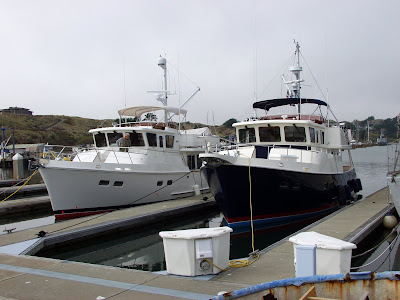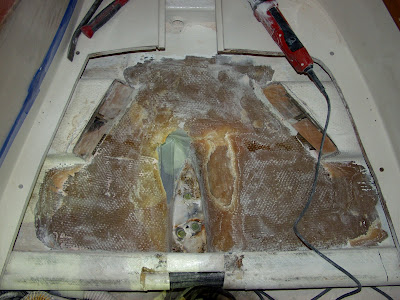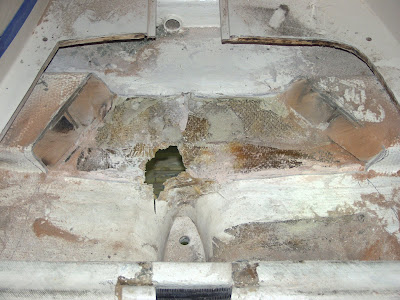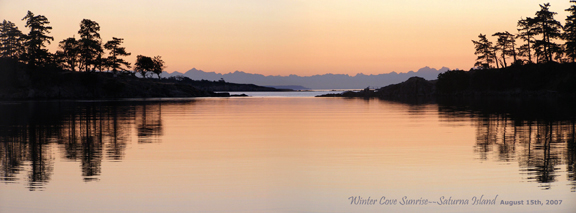What have you just seen? Read on...
While, All good things must come to an end, is a familiar quote, I did not appreciate its recent application!
On Monday, August 17th, I pulled Whisper's anchor out of Conover Cove on Wallace Island at 0640 and made slow progress toward Porlier Pass at 1500 RPM, waiting for the tide to turn. By 0830 with Porlier Pass in front of me, I increased RPMs to 2800 and watched the SOG (Speed Over Ground), normally 6.1 knots, increase to 8.4.
Once clear of the pass with its swirls & eddys and with my route across the Strait of Georgia already entered into my chartplotter, I zeroed in on the location of Musket Island near Jervis Inlet, my day's destination. Having located Musket Island, my gaze shifted to Whisper's depthsounder which had shot from 98 to 20.6 feet. I immediately reduced speed & hit the "Find Ship" soft key on my chartplotter. Simultaneously, Whisper bucked to an ABRUPT halt. Caught in the rocks with a flodding current, we wallowed for about 5 seconds, that felt like forever.
First thing to do was to get clear of the rocks and then to assess Whisper's condition. Whisper maintained propulsion & the rudder worked. I went below to discover chaos. After a quick return to the helm to insure course & safety, I removed the cabin sole to find fractures to the hull all along the starboard side of the keel. The bilge pump was working, but not totally keeping up with the water level. With use of the manual Whale Gusher pump at the helm every 10 to 15 minutes the automatic pump would shut off.
While not in a MAYDAY situation, it was time to contact the Coast Guard. Using my Uniden handheld at the helm I hailed the Coast Guard on Channel 16. Port Angeles Coast Guard responded with Victoria listening. Victoria took over & we switched to 83A; I described our condition. With Whisper making way at 5 knots and winds out of the NNW at 12-14kts, I told them my destination would be Nanaimo. They asked that I aprise them every half hour beginning at 1000.
Wind waves were 1-2 feet. To take them head on would result in too much pounding of the hull and so I quartered them--tacking up the east side of Valdes Island. At the 1000 check-in, Victoria Coast Guard informed me that they had dispatched a rescue vessel from Nanaimo to meet me in approx 45 minutes.
Fearing the wind waves outside of Gabriola Island on the north side rounding to Nanaimo, I chose to go inside of Gabriola Pass and take Dodd Narrows on the flood. As I was entering the east channel of Gabriola Pass at 1130 with Victoria Coast Guard on the VHF, a 25' Coast Guard Canada Rescue inflatable appeared on Whisper's port quarter with a crew of six. Acting as a guide dog, they pointed me through the slowest current. Even at that, turning 3000 RPM which will normally result in 7 knots through the water, at times Whisper was only able to make .3 knot SOG and some of that was crabbing. It felt like we were standing still.
Gabriola Pass has two narrows. Once through the first & most trecherous one, we pulled into the north bay to assess our situation. One of the crew, Eric Ross, joined me on Whisper to give me helm relief while I cleaned up Whisper's interior. Eric gave me the helm for both narrow passages & docking in Nanaimo.
We turned into Newcastle Marina at 1300 with my adrenaline in short supply.
As I post this blog, I am quartered in the Moby Dick motel in Nanaimo with Whisper on the hard a long block away. We got here Monday at 1300. I phoned claim information into my insurance broker to initiate a claim with the insurer. It is now Thursday morning and I am still waiting for that claims adjuster phone call.
In the meantime I have prepped the rigging to lift the mast: removed the mainsail, boom, boomvang & genoa; lifted the cabin sole and cut away the pan for damage inspection.
And now I wait...
Too late am I reminded of the watchword of the U.S. Maritime Academy: ALWAYS KNOW WHERE YOU ARE! Some lessons are too late learned.
Living on the hard & thankful to be safe,
Joe
 Even on the 10th, it could have easily been as early as 2PM. With little project management and NO customer service, it didn't happen until 4:45. Do you know how early sunset happens in those latitudes on Nov 10th? Was I going to spend another night in Nanaimo? NOT!
Even on the 10th, it could have easily been as early as 2PM. With little project management and NO customer service, it didn't happen until 4:45. Do you know how early sunset happens in those latitudes on Nov 10th? Was I going to spend another night in Nanaimo? NOT! You can see from this photo that we had a smooth crossing of the Strait of Juan de Fuca, now a part of the Salish Sea. With a decent ebb current running against us we saw our SOG drop from 6.4 to 2.8 knots. The wind finally came up enough south of Bush Point to unfurl the genoa and motorsail. That strategy got us almost an added knot. It took us 13 hours to run the 60NM through the Ballard Locks to M/V Lucky Dog at Sagstad Marina.
You can see from this photo that we had a smooth crossing of the Strait of Juan de Fuca, now a part of the Salish Sea. With a decent ebb current running against us we saw our SOG drop from 6.4 to 2.8 knots. The wind finally came up enough south of Bush Point to unfurl the genoa and motorsail. That strategy got us almost an added knot. It took us 13 hours to run the 60NM through the Ballard Locks to M/V Lucky Dog at Sagstad Marina. Whisper finished the short trip home to Lake Union on Friday. It was a good decision to make the trip when we did! The next day the storm track settled in & it has been windy & rainy ever since.
Whisper finished the short trip home to Lake Union on Friday. It was a good decision to make the trip when we did! The next day the storm track settled in & it has been windy & rainy ever since.
























.JPG)

























